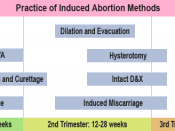Abortion, termination of pregnancy before birth, resulting in, or accompanied by, the death of the fetus. Some abortions occur naturally because a fetus does not develop normally or because the mother has an injury or disorder that prevents her from carrying the pregnancy to term. This type of spontaneous abortion is commonly known as a miscarriage. Other abortions are induced--that is, intentionally brought on--because a pregnancy is unwanted or presents a risk to a woman's health.
Induced abortion, the focus of this article, has become one of the most intense and polarizing ethical and philosophical issues of the late 20th century. Modern medical techniques have made induced abortions simpler and less dangerous. But in the United States, the debate over abortion has led to legal battles in the courts, in the Congress of the United States, and state legislatures. It has spilled over into confrontations, which are sometimes violent, at clinics where abortions are performed.
This article discusses the most common methods used to induce abortions, the social and ethical issues surrounding abortion, and the history of the regulation of abortion in the United States.
Induced abortions are performed using one of several methods. The safest and most appropriate method is determined by the age of the fetus, or the length of pregnancy, which is calculated from the beginning of the pregnant woman's last menstrual period (LMP). Most pregnancies last an average of 39 to 40 weeks. This period is divided into three stages known as trimesters. The first trimester consists of the first 13 weeks, the second trimester spans weeks 14 to 24, and the third trimester lasts from the 25th week to birth. Abortions in the first trimester of pregnancy are easier and safer to perform while abortions in the second and third trimesters...



WOW
I got a lot of information from it that I did not know. Abortion is a large debateable issuse but I belive not matter what side you are one you should know ALL the facts. Cool paper. Thanks for the info.
0 out of 0 people found this comment useful.